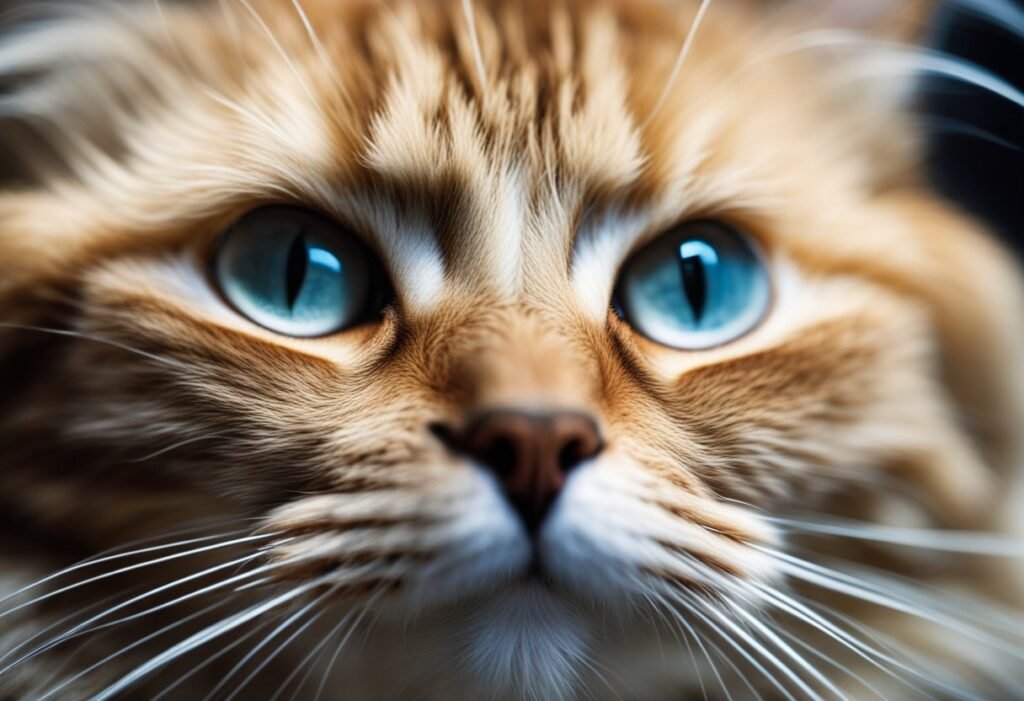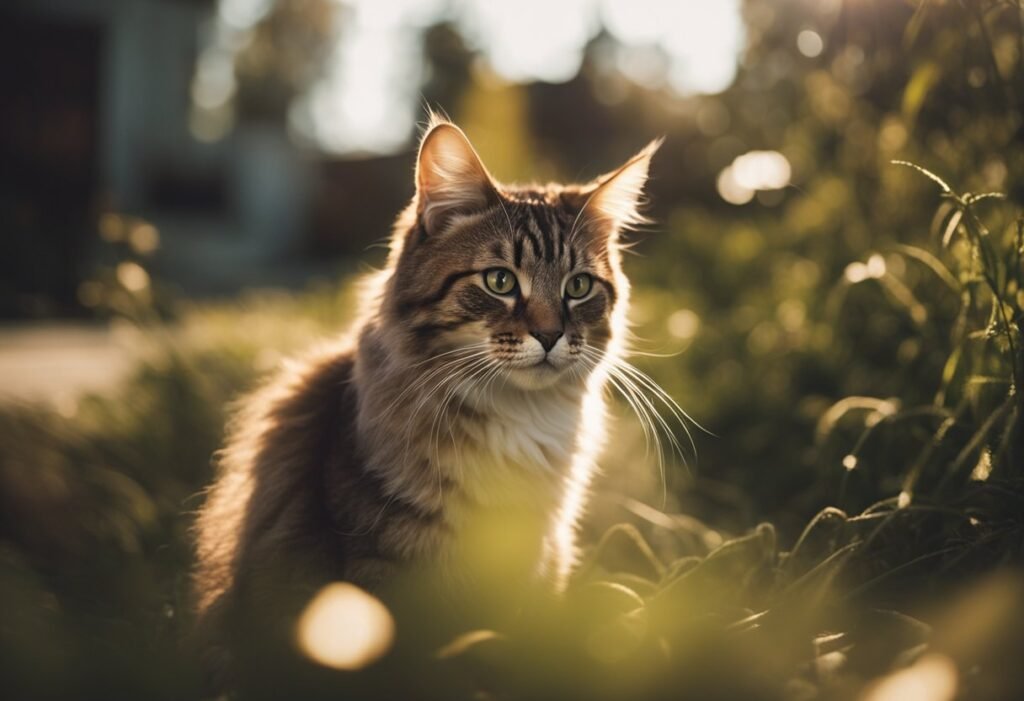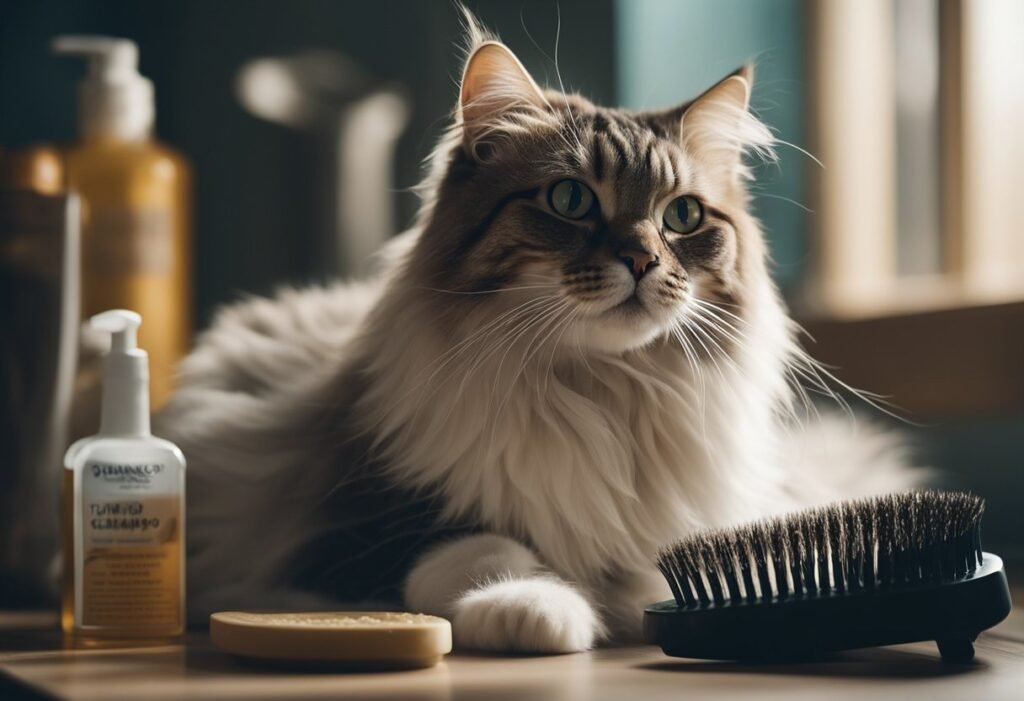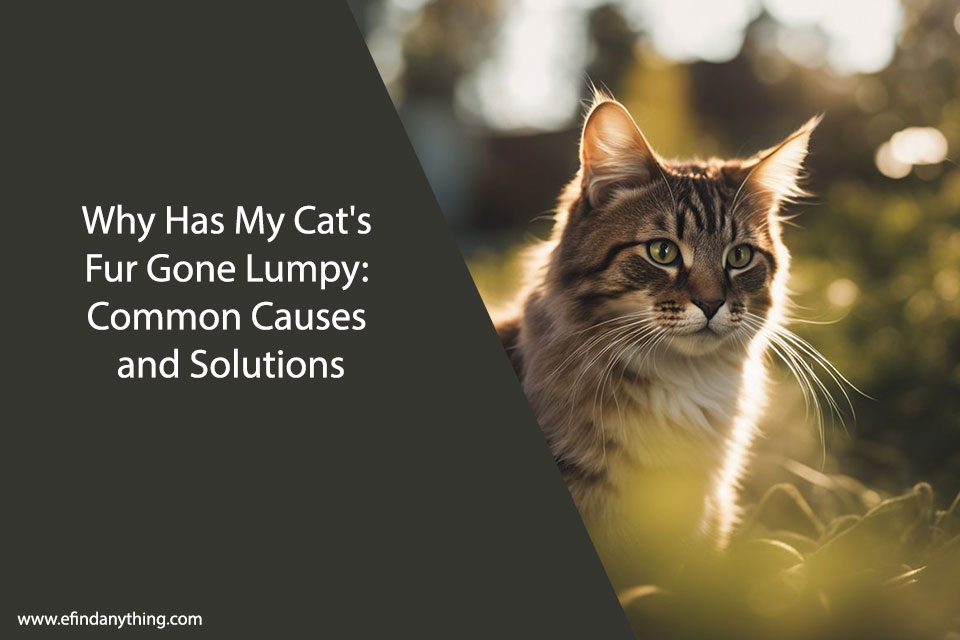If you’ve noticed your cat’s fur looking a bit lumpy or bumpy, you may be wondering what could be causing this strange phenomenon. While it’s not uncommon for cats to experience changes in their coat texture, it’s important to understand what may be causing this issue and how to address it.

One possible explanation for lumpy fur in cats is the presence of mats or tangles. These can occur when your cat’s fur becomes knotted and tangled, often due to lack of grooming or excessive shedding. Mats can be uncomfortable for your cat and may even cause skin irritation or infection if left untreated. Regular grooming and brushing can help prevent mats from forming and keep your cat’s coat looking smooth and healthy.
Another potential cause of lumpy fur in cats is skin allergies or infections. If your cat is experiencing itching, redness, or inflammation in addition to the bumpy texture of their fur, it’s possible that they may be suffering from an allergy or infection. In these cases, it’s important to consult with your veterinarian to determine the underlying cause and appropriate treatment plan.
Table of Contents
Why has my cat’s fur gone lumpy

If you’ve noticed that your cat’s fur has become lumpy, it could be a sign of an underlying health issue. Here are some possible reasons for why your cat’s fur has gone lumpy:
1. Poor diet
A poor diet lacking in essential nutrients can lead to a variety of health issues, including skin and coat problems. If your cat’s diet is lacking in essential vitamins and minerals, their fur may become dry, dull, and lumpy. Make sure your cat is getting a balanced diet that includes high-quality protein, healthy fats, and essential vitamins and minerals.
2. Skin allergies
Allergies to food, fleas, or environmental factors can cause your cat’s skin to become itchy and irritated. This can lead to excessive scratching and biting, which can cause lumps and bumps to form on their fur. If you suspect your cat has skin allergies, consult with your veterinarian to determine the best course of treatment.
3. Parasites
Fleas, ticks, and other parasites can irritate your cat’s skin and cause lumps and bumps to form on their fur. Regular flea and tick prevention, along with routine grooming, can help prevent these parasites from causing skin issues.
4. Underlying health issues
In some cases, lumpy fur can be a sign of an underlying health issue, such as thyroid problems or hormonal imbalances. If you notice other symptoms in addition to lumpy fur, such as weight loss or lethargy, consult with your veterinarian to determine the underlying cause.
Overall, if you notice that your cat’s fur has become lumpy, it’s important to take action and determine the underlying cause. By addressing the issue promptly, you can help ensure your cat’s overall health and well-being.
Understanding Cat Fur Health

Normal Fur Texture
As cat owners, we all want our furry friends to have healthy and beautiful coats. A cat’s fur should be soft, smooth, and shiny. The texture of the fur can vary depending on the breed, age, and health of the cat. Some cats may have short, fine fur, while others may have long, thick fur. However, regardless of the texture, the fur should be consistent throughout the body.
Signs of Fur Problems
Sometimes, we may notice our cat’s fur has become lumpy or matted, which can be a sign of a health problem. If you notice your cat’s fur has changed in texture or appearance, it is important to investigate the underlying cause. Here are some common reasons why a cat’s fur may become lumpy:
- Poor diet: A lack of essential nutrients in a cat’s diet can lead to dry, brittle fur that is more prone to matting.
- Skin conditions: Skin conditions such as allergies, infections, or parasites can cause irritation and lead to excessive grooming, resulting in matted fur.
- Underlying health issues: Certain health conditions such as thyroid problems or diabetes can affect a cat’s fur health.
- Lack of grooming: Older cats or cats with mobility issues may have difficulty grooming themselves, which can lead to matted fur.
As responsible cat owners, it is important to monitor our cat’s fur health and seek veterinary care if we notice any changes. Regular grooming and a balanced diet can also help maintain our cat’s fur health and keep it looking beautiful.
Common Causes of Lumpy Fur

If you’ve noticed that your cat’s fur has become lumpy, it could be a sign of an underlying health issue. In this section, we’ll explore some of the most common causes of lumpy fur in cats.
Parasitic Infections
Parasites, such as fleas, ticks, and mites, can cause lumpy fur in cats. These tiny creatures feed on your cat’s blood and can cause an allergic reaction that leads to skin irritation and the formation of lumps or bumps on the skin. Regular flea and tick prevention is essential for keeping your cat healthy and free from lumps.
Allergic Reactions
Some cats are allergic to certain foods, environmental allergens, or flea bites. An allergic reaction can cause lumpy fur, as well as other symptoms such as itching, redness, and inflammation. Identifying and avoiding the allergen is crucial in managing allergic reactions in cats.
Skin Conditions
Skin conditions such as seborrhea, ringworm, and acne can also cause lumpy fur in cats. Seborrhea is a skin condition that results in the overproduction of oil, leading to scaly, lumpy skin. Ringworm is a fungal infection that can cause circular patches of lumpy, scaly skin. Acne is a common skin condition that affects cats, causing lumps and bumps on the chin and face.
Fungal Infections
Fungal infections such as ringworm can cause lumpy fur in cats. Ringworm is highly contagious and can spread from cat to cat or from cats to humans. Treatment for fungal infections typically involves antifungal medication and thorough cleaning of the environment to prevent the spread of infection.
In conclusion, lumpy fur in cats can be caused by a variety of health issues, including parasitic infections, allergic reactions, skin conditions, and fungal infections. If you notice lumps or bumps on your cat’s skin, it’s essential to consult with your veterinarian to determine the underlying cause and develop an appropriate treatment plan.
Diet and Nutrition Impact

Essential Nutrients for Healthy Fur
A cat’s diet plays a crucial role in maintaining healthy fur. Essential nutrients like protein, omega-3 and omega-6 fatty acids, and vitamins A and E are necessary for healthy skin and fur. Protein is crucial for the growth and repair of skin cells and hair follicles, while omega-3 and omega-6 fatty acids help to maintain a healthy coat and prevent dry skin. Vitamins A and E are antioxidants that protect the skin and hair cells from damage caused by free radicals.
To ensure that your cat’s diet is providing all the essential nutrients, it’s important to choose high-quality cat food that is balanced and complete. Look for cat food that has animal-based protein as the first ingredient, and contains a balance of omega-3 and omega-6 fatty acids. Additionally, adding a supplement like fish oil to your cat’s diet can provide extra omega-3 fatty acids and improve the condition of their fur.
Effects of Poor Nutrition
Poor nutrition can have a negative impact on a cat’s fur. A diet that is deficient in essential nutrients can lead to a dull, dry, and lumpy coat. A lack of protein can result in hair loss and slow growth, while a deficiency in omega-3 and omega-6 fatty acids can cause dry, itchy skin and a dull coat. Additionally, a lack of vitamins A and E can result in flaky, dry skin and a rough coat.
It’s important to note that overfeeding can also have a negative impact on a cat’s fur. Excess weight can make it difficult for cats to groom themselves properly, leading to matting and tangling of the fur. This can result in lumpy, matted fur that is difficult to manage.
In conclusion, a cat’s diet and nutrition play a crucial role in maintaining healthy fur. Providing a balanced and complete diet that is rich in essential nutrients like protein, omega-3 and omega-6 fatty acids, and vitamins A and E can help to ensure that your cat’s fur remains healthy and lustrous.
Grooming and Care

Proper Grooming Techniques
Regular grooming is essential to maintain the quality of your cat’s fur. It helps remove loose hair, dirt, and debris that can cause matting and tangling. Brushing your cat’s fur regularly can also prevent hairballs and skin irritations. It is recommended to brush your cat’s fur at least once a week, but long-haired cats may require more frequent grooming.
When grooming your cat, use a brush or comb that is appropriate for their fur type. For example, a slicker brush is ideal for removing loose hair from long-haired cats, while a bristle brush is better suited for short-haired cats. You can also use a grooming glove to massage and remove loose hair from your cat’s coat.
Impact of Neglecting Grooming
Neglecting your cat’s grooming needs can lead to a variety of issues, including matting, tangling, and skin irritations. Matting occurs when loose hair becomes tangled and forms clumps that are difficult to remove. This can be painful for your cat and can lead to skin irritations and infections.
Tangling occurs when fur becomes twisted and knotted, which can also be painful for your cat. Tangling can also lead to matting, making it even harder to remove.
Skin irritations can occur when dirt, debris, and loose hair become trapped in your cat’s fur. This can cause itching, scratching, and even infections.
In conclusion, proper grooming techniques are essential to maintaining the quality of your cat’s fur. Neglecting your cat’s grooming needs can lead to a variety of issues, including matting, tangling, and skin irritations. By regularly grooming your cat, you can help prevent these issues and keep your cat healthy and happy.
When to Seek Veterinary Help
If you notice that your cat’s fur has become lumpy, it is important to monitor the situation closely. While some causes of lumpy fur may be harmless, others can be a sign of a serious underlying health issue. In this section, we will discuss when it is necessary to seek veterinary help.
Identifying Serious Symptoms
If your cat’s fur has become lumpy and you notice any of the following symptoms, it is important to seek veterinary help immediately:
- Loss of appetite
- Lethargy
- Vomiting
- Diarrhea
- Difficulty breathing
- Seizures
These symptoms may indicate a serious underlying health issue, such as an infection or a tumor. It is important to seek veterinary help as soon as possible in order to ensure the best possible outcome for your cat.
Benefits of Professional Diagnosis
If your cat’s fur has become lumpy, it is important to seek professional diagnosis in order to determine the underlying cause. A veterinarian can perform a physical examination and run diagnostic tests to determine the cause of the lumps.
Some benefits of seeking professional diagnosis include:
- Accurate diagnosis: A veterinarian can accurately diagnose the underlying cause of the lumps, which can help ensure the best possible treatment plan.
- Early detection: If the lumps are a sign of a serious underlying health issue, early detection can help ensure the best possible outcome for your cat.
- Peace of mind: Seeking professional diagnosis can help put your mind at ease and ensure that your cat receives the best possible care.
In conclusion, if your cat’s fur has become lumpy, it is important to monitor the situation closely and seek veterinary help if necessary. By identifying serious symptoms and seeking professional diagnosis, you can ensure the best possible outcome for your cat.
Treatment Options
Medications
If the lumpy fur is caused by an underlying medical condition, your veterinarian may prescribe medications to treat the condition. For example, if your cat has an infection, antibiotics may be prescribed. If your cat has an allergy, antihistamines or steroids may be prescribed. It is important to follow the veterinarian’s instructions carefully when administering medications to your cat.
Topical Treatments
Topical treatments can be applied directly to the affected areas of your cat’s skin to help soothe and heal the skin. These treatments may include medicated shampoos, ointments, or creams. Some topical treatments may contain ingredients such as aloe vera, oatmeal, or hydrocortisone, which can help reduce inflammation and itching.
Dietary Changes
In some cases, dietary changes may be recommended to help improve your cat’s skin and coat health. Your veterinarian may recommend a diet that is high in protein and essential fatty acids, which can help promote healthy skin and fur. Additionally, your veterinarian may recommend adding supplements such as omega-3 fatty acids or vitamin E to your cat’s diet to help improve skin and coat health.
Overall, it is important to consult with your veterinarian to determine the underlying cause of your cat’s lumpy fur and to develop an appropriate treatment plan. With proper treatment and care, your cat’s fur can become healthy and shiny once again.
Prevention Strategies
Regular Check-ups
Regular check-ups with a veterinarian can help prevent lumpy fur in cats. During these check-ups, the vet will examine your cat’s skin and fur for any signs of lumps, bumps, or other abnormalities. They may also recommend blood tests or other diagnostic tests to check for underlying health issues that could be causing the lumpy fur.
Preventive Care Tips
In addition to regular check-ups, there are several preventive care tips that can help keep your cat’s fur healthy and lump-free. These include:
- Regular grooming: Regular grooming can help prevent matting and tangling of your cat’s fur, which can lead to lumps and bumps.
- Proper nutrition: A balanced diet can help keep your cat’s skin and fur healthy. Make sure your cat is getting all the necessary nutrients, including protein, vitamins, and minerals.
- Hydration: Make sure your cat has access to fresh water at all times. Dehydration can lead to dry skin and fur, which can make lumps and bumps more likely.
- Stress reduction: Stress can have a negative impact on your cat’s health, including their skin and fur. Try to minimize stressors in your cat’s environment, and provide plenty of opportunities for play and relaxation.
By following these preventive care tips and scheduling regular check-ups with your veterinarian, you can help keep your cat’s fur healthy and lump-free.
Frequently Asked Questions
What causes matting in a cat’s fur?
Matting in a cat’s fur can be caused by a variety of factors, including poor grooming habits, lack of regular brushing, and underlying health issues. Cats with long hair are more prone to matting, as their fur is more likely to tangle and knot.
How can I prevent my cat’s fur from matting?
Regular grooming is key to preventing matting in your cat’s fur. Brushing your cat’s fur daily can help prevent tangles and knots from forming. If your cat has long hair, consider getting them a haircut to make it easier to manage.
What are the signs of kidney disease related to cat fur matting?
Kidney disease can cause a variety of symptoms in cats, including matting of the fur. If you notice that your cat’s fur is becoming increasingly matted and they are also experiencing other symptoms such as weight loss, decreased appetite, and increased thirst, it may be a sign of kidney disease. It’s important to take your cat to the vet for a proper diagnosis and treatment.
How do you safely remove matted fur from a cat?
It’s important to approach removing matted fur from your cat carefully to avoid causing them pain or discomfort. Use a comb or dematting tool to gently work through the mat, starting at the edges and working your way inwards. If the mat is too severe, it may be necessary to have it professionally removed by a groomer or veterinarian.
Can a cat’s diet affect the condition of its fur?
Yes, a cat’s diet can have a significant impact on the condition of their fur. Feeding your cat a high-quality, balanced diet can help promote healthy skin and fur. Make sure your cat is getting enough protein, vitamins, and minerals in their diet to maintain a healthy coat.
Why might an older cat develop matted fur more frequently?
As cats age, they may become less flexible and have a harder time grooming themselves effectively. This can lead to more frequent matting of the fur. Additionally, older cats may be more prone to health issues that can cause matting, such as arthritis or kidney disease. Regular grooming and veterinary check-ups can help prevent and manage matting in older cats.





